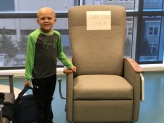Discovery of New Targets and Pathways for T-ALL Therapy
Institution:
Dana-Farber Cancer InstituteResearcher(s):
Thomas LookGrant Type:
Bridge GrantsYear Awarded:
2012Type of Childhood Cancer:
Acute Lymphoblastic Leukemia (ALL)Project Description:
 For Thomas Look, MD, vice chair for research in the Department of Pediatric Oncology at Dana-Farber Cancer Institute, a Bridge Grant from the Alex’s Lemonade Stand Foundation was critical to his research into the genetic pathways drive T-cell acute lymphoblastic leukemia (T-ALL). The goal of the project is to identify genes and proteins that can serve as targets for more-effective, less-toxic therapies for this disease, which accounts for 10-15 percent of all cases of childhood ALL.
For Thomas Look, MD, vice chair for research in the Department of Pediatric Oncology at Dana-Farber Cancer Institute, a Bridge Grant from the Alex’s Lemonade Stand Foundation was critical to his research into the genetic pathways drive T-cell acute lymphoblastic leukemia (T-ALL). The goal of the project is to identify genes and proteins that can serve as targets for more-effective, less-toxic therapies for this disease, which accounts for 10-15 percent of all cases of childhood ALL.The intensification of therapy for children with T-cell acute lymphoblastic leukemia (T-ALL) has improved clinical outcomes substantially, but first-line therapy continues to fail in approximately 25% of children, and after initial failure these patients have a very poor prognosis. Our long term goal is to improve the targeted therapy of the high risk subset of T-ALL patients. The central hypothesis underlying this proposal is that treatment resistance in high-risk T-ALL patients is mediated by innate resistance to undergo cell death, due in a significant fraction of patients to PTEN loss contributing to PI3K activation. The primary objective is to establish the level of innate resistance to cell death in primary T-ALL cells from high risk cases and to reduce the level of these cell survival signals and induce death of these cells. The successful completion of these studies will revolutionize therapy for the ABD subset of children with high-risk T-ALL, which accounts for 62% of induction failures as well as 19% of relapses in pediatric T-ALL.
Update 5/2013 Dr. Look has made a surpising and unprecedented discovery that most of T-ALL cells are addicted to the TYK2 pathways for their survival! Thus, his studies indicate that TYK2 kinase inhibition with small-molecule inhibitors will very likely lead to novel first-in-class therapies to improve the cure rate for T-ALL patients.
“The Bridge Grant enabled me to keep my lab team together, and the research itself on track, while I resubmitted an R01 research grant to the National Institutes of Health,” Look says. “The continuity it provided was essential. The research is now funded for a full five years.”
"We have worked on the development of novel druggable pathways that can provide new targets to significantly improve T-ALL therapies, and established the surprising and previously unprecedented discovery that most of T-ALL cells are addicted to the TYK2 pathway for their survival. TYK2 is one of the JAK family kinase proteins, which are intracellular mediators known to be involved in cell proliferation, survival, and differentiation, and abnormalities in JAK kinases are closely linked to the pathogenesis of hematological malignancies. We identified that TYK2 and its downstream effector STAT1 mediates T-ALL cell survival through the upregulation of pro-survival protein BCL2, and confirmed that the small-molecule inhibitors that are active against TYK2 effectively induce the death of T-ALL cells. Thus, our studies indicate that TYK2 kinase inhibition with small-molecule inhibitors will very likely lead to novel first-in-class therapies to improve the cure rate for T-ALL patients."

